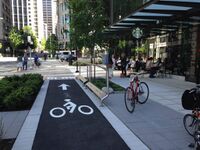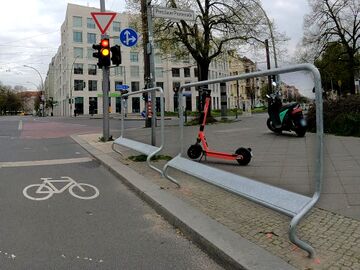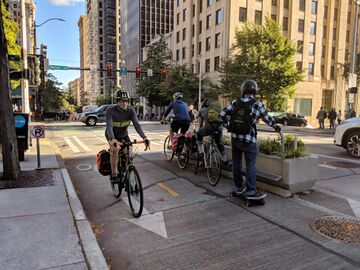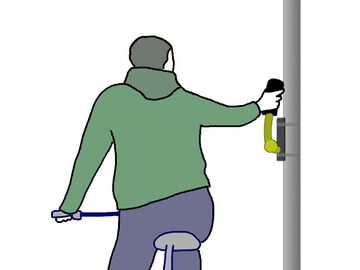Tag:highway=cyclist_waiting_aid
| Description |
|---|
| Street furniture and devices for cyclists that are intended to make waiting at esp. traffic lights more comfortable. |
| Group: bicycles |
| Used on these elements |
| Useful combination |
| See also |
| Status: approved |
| Tools for this tag |
|
The tag highway=cyclist_waiting_aid is used to map devices for cyclists that are intended to make waiting at esp. traffic lights more comfortable.
Known as "cyclist footrests", "leaning rails" or "bike rests", they often include footrests and handrails. Also other types are existing, like single handgrips mounted directly on traffic light masts.
These "waiting aids" make it possible to rest one foot or lean on your hand while waiting. When continuing the ride, you can start cycling more quickly and safely. In a few cities they have been a common item of street furniture for many years (e.g. in some cities in Denmark and Sweden), in many other cities they are increasingly being installed as part of the efforts to promote cycling.
How to map
Add a ![]() with highway=cyclist_waiting_aid on the way (cycleway, path or other highway) next to the location of the waiting aid device. Connect the node to the way to make it easier to include the waiting aids in route planning and other applications. If there are several such devices in a row, place the node at the "first" waiting position (closest to the e.g. traffic lights/front of the queue).
with highway=cyclist_waiting_aid on the way (cycleway, path or other highway) next to the location of the waiting aid device. Connect the node to the way to make it easier to include the waiting aids in route planning and other applications. If there are several such devices in a row, place the node at the "first" waiting position (closest to the e.g. traffic lights/front of the queue).
If possible or necessary, add further details:
- Direction of travel: If the node is placed on a way that can be used by cyclists in both directions, indicate the direction=* in which the waiting aid is available (forward or backward, depending on direction of way).
- Specify components: Depending on the design of the waiting aid, add subtags for the existence of foot- or handrests (yes or no):
- Specifying side of use: Add the tag side=* to indicate whether the waiting aid feature is located on the left or right side of the way, seen in the direction of travel of a waiting aid user (resp. on which side you can rest your leg or hand). In rare cases, also both might be possible if there are waiting aid features on both sides of the way.
- Additional useful tags: Other suitable tags can be added to specify physical properties (like material=*, height=*, support=*) or to indicate the number of devices (count=*) or of cyclists that can wait there at the same time (capacity=*).
Avoid merging the waiting aid node with other nodes (like traffic signals or advanced stop lines). Usually, they are not in the same place when the waiting aid is mapped at the location of the first waiting position (see above). Some exemplary cases:
- At a traffic light, the waiting aid is usually located a few metres behind the stop line. Traffic lights and waiting aids can therefore be mapped with different nodes. For evaluations, they are clearly related via the connected highway line and their direction.
- Even in combination with an cycleway=asl, the waiting aid should be mapped slightly behind the node for the ASL.
- If a waiting aid is located directly on a pedestrian island (highway=crossing + crossing:island=yes), a shared node can be avoided by mapping the pedestrian island separately (with surrounding road segments). For those who find this too complex, the waiting aid should be placed slightly next to the crossing node.
Examples
A common waiting aid combining a footrest and a handrail.
highway=cyclist_waiting_aid
footrest=yes
handrest=yes
side=leftTwo waiting aids for cyclists on the right side of a cycleway.
highway=cyclist_waiting_aid
footrest=yes
handrest=yes
side=right
material=metal
count=2
(Using count=* to specify the number of devices instead if capacity=* in this case, as it is not necessarily clear how many cyclists can use a waiting aid device at a time.)Foot- and handrests on a planter (bi-directional cycleway).
highway=cyclist_waiting_aid
direction=backward
footrest=yes
handrest=yes
side=right
count=3
(Assuming the way is directed like the arrow on the cycleway, the device is used in backward direction and is located on the left side of the OSM way, but it's located on the right side=* for the users.)Simple bollards with a foot peg and and a handhold.
highway=cyclist_waiting_aid
handrest=yes
footrest=yes
direction=(forward/backward)
side=right
material=metal
capacity=3
(For a two-way cycleway, direction=* specifies which travel direction along the OSM way the aids are intended for. Using capacity=*, because each bollard only support one cyclist.)
See also
- cycleway=asl –
 advanced stop line (ASL), a marked area for cyclists in front of the stop line for motor traffic.
advanced stop line (ASL), a marked area for cyclists in front of the stop line for motor traffic.





